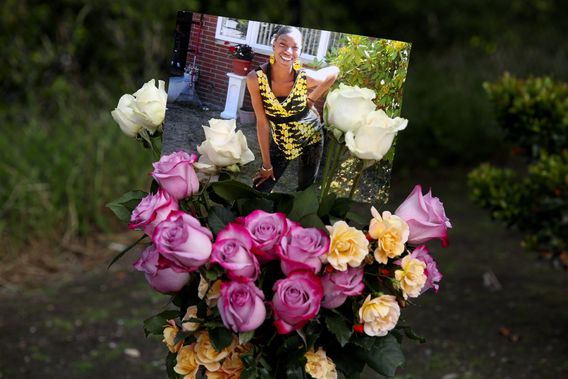The department’s Force Review Board found the two officers used proper tactics and decision-making, followed their training and did not violate policies, according to sources.
The Seattle Police Department’s Force Review Board has found the fatal shooting of Charleena Lyles by two officers in June to be reasonable, proportional and within policy, according to sources familiar with the decision.
The board’s unanimous vote occurred during a meeting Tuesday that began at 9 a.m. and lasted until about 5 p.m., said one source with direct knowledge of the proceeding.
The findings are subject to final approval from Assistant Chief Lesley Cordner, who presided over the meeting and oversees the department’s Compliance and Professional Standards Bureau, the source said.
Corey Guilmette, an attorney representing Lyles’ family, issued a statement Wednesday night, saying, “We cannot accept that Charleena Lyles’ killing was unavoidable. If her killing was within policy and training, we need changes in policy and training.”
Charleena Lyles shooting

- Charleena Lyles loved her children, dancing and Fourth of July, says brother of woman killed by Seattle police
- Seattle police officers had no viable alternatives when they fatally shot Charleena Lyles, review board finds
- Lyles’ alleged threat to kill boy wasn’t reported to police
- Civil lawsuit filed against Seattle police officers who fatally shot Charleena Lyles
- Family of Charleena Lyles begins legal action against city of Seattle
- Charleena Lyles had long turned to Seattle police for help before fatal confrontation
- Victim advocate: Charleena Lyles faced boyfriend’s escalating violence
- Seattle mother of 4 shot by police was getting mental-health help, records show
- ‘Get back! Get back!’: Seattle police release audio of fatal shooting of Charleena Lyles
- Seattle officer who shot Charleena Lyles under investigation for leaving Taser in locker
- Police transcript of fatal shooting of Charleena Lyles: ‘I don’t have a taser’
- Fatal shooting of black woman by white officers met with widespread outrage
- Seven years on, and Seattle still doesn't have police body cameras | Danny Westneat
Lyles, a 30-year-old African-American mother of four, was shot seven times by Officers Steven McNew and Jason Anderson on June 18 after she called 911 to report a burglary at her Northeast Seattle apartment. Police said Lyles suddenly threatened the officers inside the apartment with one or two knives before they opened fire.
The officers found no evidence of a burglary, according to police.
Lyles had struggled with mental-health issues, according to her family and court records, and the shooting came at a time her life was spinning out of control.
The shooting unleashed a storm of public protest, with many seeing it as another example of unnecessary deadly force being used by police against people of color. Lyles’ family members have said they believe race was a factor. The officers who shot her are white.
The Force Review Board was created as part of a 2012 consent decree between the city and the U.S. Justice Department to address excessive force and biased policing in the Police Department. It replaced the Firearms Review Board, which had been criticized over the depth of its work.
In Tuesday’s review, the board, consisting of about 15 members of the department, found the officers used proper tactics and decision-making, followed their training and did not violate policies regarding de-escalation and crisis-intervention training, according to the sources.
The findings will be documented in a written report, which will articulate the basis for the conclusions.
In reaching its conclusions, the board considered statements from the two officers taken shortly after the shooting. The statements, contained in 86 pages of transcripts of recorded interviews, were released by police days after the shooting.
Anderson told investigators Lyles was speaking calmly with the officers when she suddenly pulled a knife out of her pocket and was “coming right at my stomach.” He said he jumped back and sucked in his abdomen to avoid getting stabbed in the stomach with a knife 4 to 5 inches long.
Anderson said he drew his pistol, asked for fast backup on his radio and, along with McNew, told Lyles to “get back.”
Anderson said McNew asked him to use his Taser on Lyles, but he told McNew he didn’t have a Taser. He acknowledged he failed to report to his superiors that he was no longer carrying a Taser — the lack of notification a possible violation of department policy.
Lyles then began quickly advancing on McNew, Anderson said, describing himself as in “fear that she was gonna try and kill my partner um ’cause she was going after him.”
As Lyles turned a corner to go after McNew, Anderson said, he fired from 4 to 5 feet away and saw Lyles fall to the floor.
McNew, who carried a baton but didn’t have a Taser, said in his statement that he fired his handgun because he felt like he didn’t have any other options
Anderson said he wasn’t carrying a Taser because the battery had died two weeks earlier, but he told investigators he wouldn’t have used it anyway because he was trained to use lethal force when attacked with a knife.
Anderson said he was the first officer called to the scene, and asked for a second officer after discovering there was an officer-safety caution on Lyles stemming from a June 5 domestic-disturbance incident. In that case, Lyles threatened the officers with a pair of long scissors before dropping them.
But Anderson said there was no need to frisk Lyles in the June 18 incident because it was a typical burglary call.
He said Lyles’ demeanor had changed so quickly he did not have time to employ de-escalation techniques.
McNew said he considered running out of the apartment, but he couldn’t because Lyles was visibly agitated, holding two knives, with her children at her feet.
The Police Department’s Office of Police Accountability, which conducts internal investigations, is looking into whether Anderson’s actions regarding his Taser violated department policy.
A separate inquest has been set for April 16, in which a jury will determine the causes and circumstances of the shooting, followed by King County Prosecutor Dan Satterberg’s decision whether to file criminal charges against the officers.
